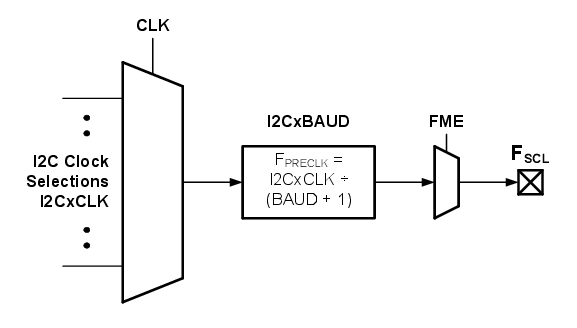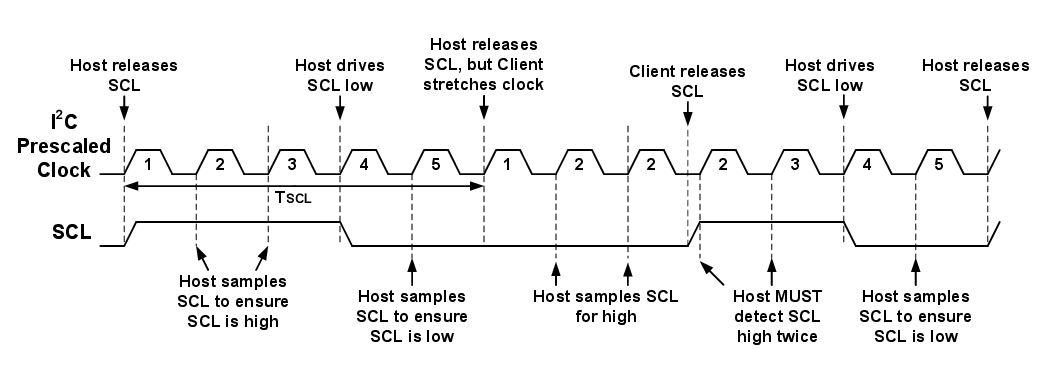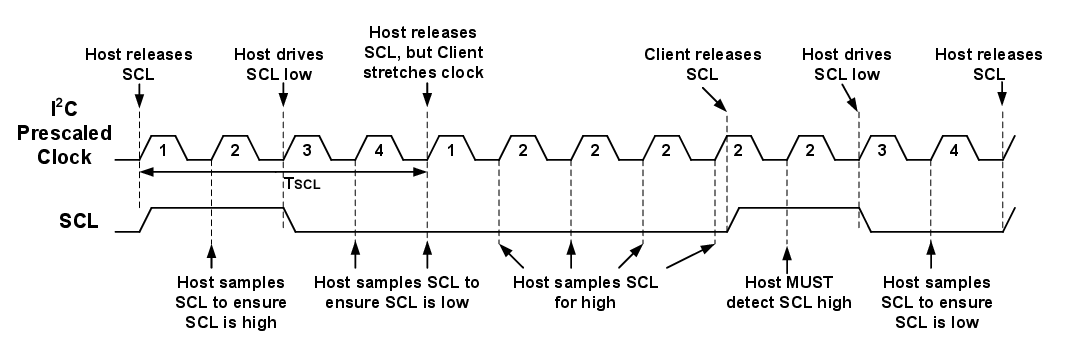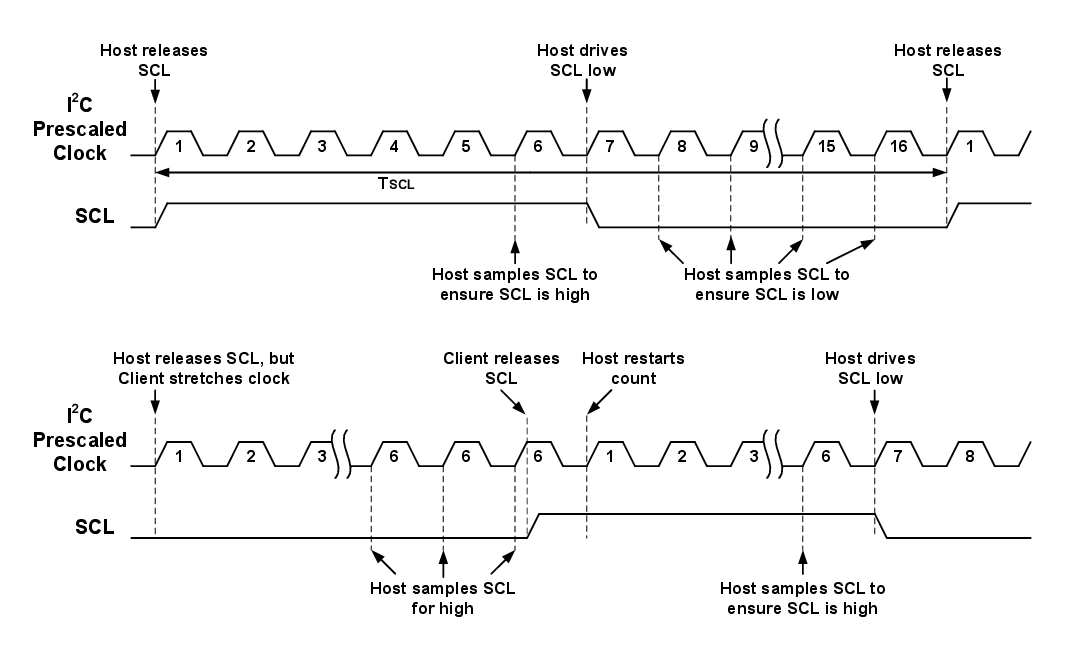37.4.2.2 Host Clock Timing
The Serial Clock (SCL) signal is generated by module hardware via the I2C Clock Selection (I2CxCLK) register, the I2C Baud Rate Prescaler (I2CxBAUD) register, and the Fast Mode Enable (FME) bits.
The figure below illustrates the SCL clock generation.

I2CxCLK contains several clock source selections. The clock source selections typically include variants of the system clock and timer resources.
I2CxBAUD is used to determine the prescaler (clock divider) for the I2CxCLK source.
The FME bit acts as a secondary divider to the prescaled clock source.
When FME = 0, one SCL period (TSCL) is equal to five clock
periods of the prescaled I2CxCLK source. In other words, the prescaled I2CxCLK source is
divided by five. For example, if the HFINTOSC (set to 4 MHz) clock source is selected,
I2CxBAUD is loaded with a value of ‘7’, and FME = 0,
the actual SCL frequency is 100 kHz (see the equation below).
0)- I2CxCLK: HFINTOSC (4 MHz)
- I2CxBAUD:
7 - FME: FME =
0
When FME = 0, host hardware uses the first prescaled I2CxCLK source
period to release SCL, allowing it to float high (see the figure below). Host hardware
then uses the second and third periods to sample SCL to verify that SCL is high. If a
client is holding SCL low (clock stretch) during the second and/or third period, host
hardware samples each successive prescaled I2CxCLK period until a high level is detected
on SCL. Once the high level is detected, host hardware samples SCL during the next two
I2CxCLK periods to verify that SCL is high. The host hardware then uses the fourth
prescaled I2CxCLK source period to drive SCL low. During the fifth period, host hardware
verifies that SCL is in fact low.
0, up to fSCL = 100 kHz)
When FME = 1, one SCL period (TSCL) is equal to four clock
periods of the prescaled I2CxCLK source. In other words, the prescaled I2CxCLK source is
divided by four. Using the example from above, if the HFINTOSC (4 MHz) clock source is
selected, I2CxBAUD is loaded with a value of ‘7’, and FME =
1, the actual SCL frequency is 125 kHz (see the equation
below).
1)- I2CxCLK: HFINTOSC (4 MHz)
- I2CxBAUD:
7 - FME: FME =
1
When FME = 1, host hardware uses the first prescaled I2CxCLK source
period to release SCL, allowing it to float high (see the figure below). Host hardware
then uses the second period to sample SCL to verify that SCL is high. If a client is
holding SCL low (clock stretch) during the second period, host hardware samples each
successive prescaled I2CxCLK period until a high level is detected on SCL. Once the high
level is detected, host hardware samples SCL during the next period to verify that SCL
is high. The host hardware then uses the third period to drive SCL low. During the
fourth prescaled period, host hardware verifies that SCL is in fact low.
1, up to fSCL = 400 kHz)
When FME = 2, one SCL period (TSCL) is equal to 16 clock
periods of the prescaled I2CxCLK source. In other words, the prescaled I2CxCLK source is
divided by 16. Using the example from above, if the HFINTOSC (64 MHz) clock source is
selected, I2CxBAUD is loaded with a value of ‘3’, and FME =
2, the actual SCL frequency is 1 MHz (see the equation below).
2, up to fSCL = 1 MHz)- I2CxCLK: HFINTOSC (64 MHz)
- I2CxBAUD:
3 - FME: FME =
2
When FME = 2, host hardware uses the first prescaled I2CxCLK source
period to release SCL, allowing it to float high (see the figure below). Host hardware
then uses the sixth period to sample SCL to verify that SCL is high. If a client is
holding SCL low (clock stretch) during the sixth period, host hardware samples each
successive prescaled I2CxCLK period until a high level is detected on SCL. Once the high
level is detected, host hardware samples SCL during the next six I2CxCLK periods to
verify that SCL is high. The host hardware then uses the seventh prescaled I2CxCLK
source period to drive SCL low. During eighth through sixteenth periods, host hardware
verifies that SCL is in fact low.
2, up to fSCL = 1 MHz)
The following tables show the different FME Bit Options and Common I2CxBAUD Divider Settings for different modes of I2C operation.
| I2C Mode | Valid FME Bit Options |
|---|---|
| Standard mode (Max fSCL = 100 kHz) | FME = 0, 1,
2 |
| Fast mode (Max fSCL = 400 kHz) | FME = 1, 2 |
| Fast mode+ (Max fSCL = 1 MHz) | FME = 2 |
|
I2CxCLK Osc Freq |
fSCL = 1 MHz FME = 2 |
fSCL = 400 kHz FME = 1 |
fSCL = 100 kHz FME = 1 |
fSCL = 10 kHz FME = 1 |
|---|---|---|---|---|
| I2CxBAUD Values | ||||
| 64 MHz | 3 | 39 | 159 | - |
| 32 MHz | 1 | 19 | 79 | - |
| 16 MHz | 0 | 9 | 39 | - |
| 8 MHz | - | 4 | 19 | 199 |
| 4 MHz | - | - | 9 | 99 |
| 2 MHz | - | - | - | 49 |
| 1 MHz | - | - | - | 24 |
